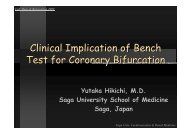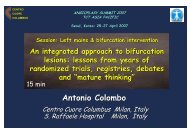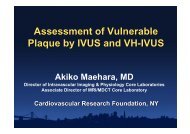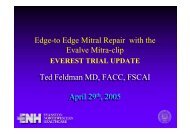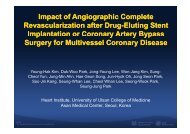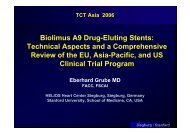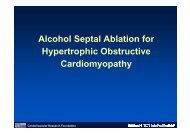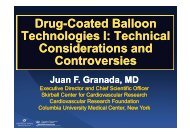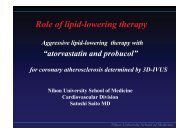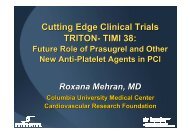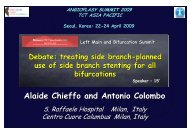CiloTax StentTM - summitMD.com
CiloTax StentTM - summitMD.com
CiloTax StentTM - summitMD.com
You also want an ePaper? Increase the reach of your titles
YUMPU automatically turns print PDFs into web optimized ePapers that Google loves.
<strong>CiloTax</strong> Stent TM<br />
Dual Drug-eluting Stent<br />
13th<br />
Angioplasty<br />
Summit 2008<br />
Cheol Whan Lee, MD<br />
University of Ulsan,<br />
Asan Medical Center,<br />
Seoul, Korea<br />
CardioVascular Research Foundation<br />
Asan Medical Center
First Generation DES<br />
Thinking the unthinkable!<br />
Current DES Systems<br />
Efficacy & Safety Issues<br />
• Restenosis results from multiple mechanisms &<br />
remains a significant problem in <strong>com</strong>plex lesions.<br />
• Stent thrombosis is a rare (0.2-1.8%), but feared<br />
<strong>com</strong>plication of PCI associated with a high mortality.
Moving Forward<br />
Co-drug<br />
Eluting Stent<br />
Potential Advantages<br />
• Current DES have used single agents,<br />
which is focusing on SMC proliferation.<br />
• Co-drug DES may allow differential targeting<br />
with synergism and minimal toxicity.
Pharmacologic Effects<br />
Cilostazol<br />
A PDE III inhibitor<br />
Pharmacologic Effects<br />
- antiplatelet<br />
- antiproliferative (VSMC)<br />
- EC protection
A Potent Anti-platelet Agent<br />
Effects of Cilostazol on Stent Thrombosis<br />
0.5<br />
0.5%<br />
Stent thrombosis (%)<br />
0.25<br />
0.0<br />
Dual therapy<br />
(n=1,597)<br />
P=0.024<br />
0.1%<br />
Triple therapy<br />
(n=1,415)<br />
Compared with the dual antiplatelet regimen, triple therapy was<br />
more effective in preventing thrombotic <strong>com</strong>plications after BMS<br />
stenting without an increased risk of side effects.<br />
Lee SW et al, J Am Coll Cardiol 2005;46:1833
CREST Trial<br />
Anti-restenotic Effect<br />
Cilostazol (n=354)<br />
Control (n=351)<br />
mm<br />
Late loss<br />
mm<br />
In-stent restenosis<br />
1.0<br />
0.5<br />
0.75<br />
0.57<br />
P
Anti-restenotic Effect<br />
DECLARE - Long and Diabetes Study<br />
Cilostazol (n=354)<br />
Control (n=351)<br />
Cilostazol (n=200)<br />
Control (n=200)<br />
Restenosis rate (%)<br />
20<br />
15<br />
10<br />
5<br />
Long lesion treated with DES<br />
11.2<br />
6.7<br />
P=0.104<br />
20<br />
15<br />
10<br />
5<br />
Diabetes treated with DES<br />
15.6<br />
8.0<br />
P=0.033<br />
0<br />
Cilostazol taken orally after DES implantation significantly<br />
reduced the rate of restenosis.<br />
0<br />
Lee SW, et al Am J Cardiol 2007;100:1103<br />
J Am Coll Cardiol 2008;51:1181
Cilostazol-eluting Stent<br />
in a Porcine Coronary Model<br />
Anti-restenotic Effect<br />
2.5<br />
2<br />
CES (n=6)<br />
BMS (n=5)<br />
1.5<br />
1<br />
0.5<br />
P=0.04<br />
P=0.03<br />
400 µg/18mm stent<br />
0<br />
Intimal area<br />
(mm 2 )<br />
Late loss<br />
(mm)<br />
Tsuchikane E, et al. J Invasive Cardiol 2007;19(3):109
The Ideal Combination?<br />
Cilotax TM Stent<br />
Dual-Drug DES<br />
Potential Synergism with Paclitaxel<br />
Cilostazol<br />
1. Anti-platelet effect<br />
stent thrombosis ↓<br />
2. Anti-proliferative effect<br />
restenosis ↓
Cilotax Stent TM<br />
Stent Platform (RS Stent)<br />
L605 cobalt chromium<br />
-thinner<br />
-stronger<br />
- bio<strong>com</strong>patible
Cilotax Stent TM<br />
Polymer & Drugs<br />
Polymer (1: 1 mixture)<br />
- cellulose acetate butyrate<br />
(durable, bio<strong>com</strong>patible)<br />
- resomer (bioabsorbable)<br />
- coating thickness: ~ 8µm<br />
Drugs<br />
paclitaxel = 1μg/mm2<br />
cilostazol = 6μg/mm2
Cilotax Stent TM<br />
Cilotax TM In-Vitro Drug Release Kinetics
Safety and Efficacy<br />
of the Cilotax TM Stent<br />
in a Porcine Coronary Model<br />
Animal Study
Objectives<br />
We tested whether the Cilotax TM stent system<br />
is safe & effective at preventing neointimal proliferation<br />
<strong>com</strong>pared with BMS in a porcine model of restenosis.
Animal Preparation<br />
• Juvenile swine (25-30 kg), n=7<br />
• Anesthesia:<br />
- ketamine (15-20 mg/kg IM),<br />
- xylazine(2 mg/kg IM)<br />
• 6F sheath via carotid or femoral artery<br />
• Aspirin 100mg, plavix 37.5mg PO for 28 days<br />
• Heparin 300 unit/kg intravenous injection
Stent Implantation<br />
• Stents were implanted at LAD or LCX (RCA).<br />
- balloon injury using oversized balloon<br />
- stent size: 18 mm, 3.0/3.5<br />
- B/A ratio (∼1.5), maximum pressure (∼14 atm)
Analysis<br />
• Angiography and IVUS:<br />
- immediate post-stenting & 1 month follow-up<br />
• Histopathomorphometric study at 1 month:<br />
- perfusion fixation using 10% buffered formalin<br />
- H&E, Carstair’s fibrin content<br />
- Digital morphometry<br />
• Statistical analysis<br />
- nonparametric Kendall’s W test<br />
- nonparametric Wilcoxon/Kruskal-Wallis test<br />
- significance: p
Results<br />
Systemic drug levels<br />
and out<strong>com</strong>es during follow-up<br />
• Cilostazol & taxol were not detectable<br />
systemically by HPLC method.<br />
• There were no stent thrombosis<br />
or death during 1-month follow-up.
Results<br />
3.0<br />
18mm<br />
Cilotax BMS<br />
4 weeks<br />
Follow-up<br />
3.0<br />
18mm
Results<br />
QCA Analysis (n=7)<br />
BMS Cilotax p-value<br />
Reference diameter<br />
MLD, post<br />
MLD, follow-up<br />
DS, post<br />
DS, follow-up<br />
Acute gain<br />
Late loss<br />
2.51±0.27<br />
2.75±0.27<br />
1.49±0.53<br />
-10.8±7.9<br />
39.9±16.6<br />
0.57 ±0.28<br />
1.26±0.47<br />
2.67±0.12<br />
2.74±0.14<br />
2.65±0.13<br />
-13.4±8.2<br />
2.8±2.8<br />
0.39±0.20<br />
0.09±0.08<br />
MLD: minimal lumen diameter, DS: diameter stenosis<br />
0.174<br />
0.943<br />
0.001<br />
0.540<br />
0.001<br />
0.173<br />
IVUS Analysis at Follow-Up (n=7)<br />
BMS Cilotax p-value<br />
Proximal margin<br />
Vessel area, mm2<br />
Lumen area, mm2<br />
% area stenosis<br />
Distal margin<br />
Vessel area, mm2<br />
Lumen area, mm2<br />
% area stenosis<br />
Within the stent<br />
Lumen area, mm 2<br />
% stent area stenosis<br />
Neointimal thickness, mm<br />
Neointimal area, mm 2<br />
10.53±3.38<br />
6.16±2.43<br />
40.1±21.1<br />
7.90±2.44<br />
4.89±1.38<br />
35.3±15.3<br />
4.30±1.85<br />
51.8±19.4<br />
0.75±0.28<br />
10.58±1.58<br />
8.87±1.76<br />
15.9±12.2<br />
7.32±1.65<br />
6.03±1.26<br />
17.1±6.2<br />
7.19±1.58<br />
6.6±10.4<br />
0.09±0.10<br />
0.975<br />
0.035<br />
0.022<br />
0.611<br />
0.134<br />
0.020<br />
0.009<br />
Histopathologic Examination<br />
Results
Results<br />
BMS (n=3)<br />
Cilotax<br />
stent (n=4)<br />
P value<br />
EEL area, mm 2<br />
7.40 ± 2.50 7.17 ± 1.01 0.872<br />
IEL area, mm 2 6.32 ± 2.17 5.82 ± 1.23 0.710<br />
Stent area, mm 2 6.32 ± 2.17 5.53 ± 0.58 0.508<br />
Lumen area, mm 2 3.80 ± 1.34 4.34 ± 0.66 0.504<br />
Intimal area, mm 2 2.52 ± 0.98 1.48 ± 0.63 0.144<br />
Medial area, mm 2 1.08 ± 0.33 1.35 ± 0.32 0.320<br />
Stenosis, %<br />
38.61 ± 5.35<br />
24.91 ± 5.26<br />
0.020<br />
Intimal thickness, mm<br />
0.39 ± 0.09<br />
0.21 ± 0.04<br />
0.019<br />
Injury score<br />
0.59 ± 0.39<br />
0.33 ± 0.24<br />
0.478
Results<br />
Vessel Healing<br />
BMS (n=3)<br />
Cilotax<br />
stent (n=4)<br />
P value<br />
Fibrin, %<br />
15.67 ± 17.2<br />
97.85 ± 3.01<br />
0.0002<br />
Mean fibrin score<br />
0.11 ± 0.19<br />
2.83 ± 0.33<br />
0.0262<br />
Malapposition, %<br />
0.00 ± 0.00<br />
61.88 ± 23.6<br />
0.0068<br />
RBC, %<br />
3.40 ± 5.88<br />
35.43 ± 7.13<br />
0.0015
Results<br />
Inflammatory Response<br />
BMS (n=3)<br />
Cilotax<br />
stent (n=4)<br />
P value<br />
Intimal<br />
inflammation<br />
score<br />
0.67 ± 0.67<br />
2.67 ± 0.27<br />
0.0323<br />
Adventitial<br />
inflammation<br />
score,<br />
1.44± 1.02<br />
2.75 ± 0.50<br />
0.0666<br />
Giant cells, %<br />
0.00 ± 0.00<br />
0.00 ± 0.00<br />
N/A
Conclusions<br />
• The Cilotax stent system was safe and effective<br />
in inhibiting neointima formation <strong>com</strong>pared with<br />
BMS at 4 weeks in a porcine coronary model.<br />
• Histologic analysis showed that the Cilotax<br />
stent induced more inflammatory response &<br />
delayed arterial healing than bare-metal stent.
Clinical Study<br />
Efficacy and Safety<br />
of the Cilotax TM Stent<br />
Phase 1/2 Clinical Trial (Pilot Study)
Hypothesis<br />
The co-drug formulation of cilostazol (6µg/mm2) plus<br />
paclitaxel (1µg/mm2) may attenuate the risk of stent<br />
thrombosis and potentially reduce the risk of restenosis<br />
as <strong>com</strong>pared with paclitaxel alone.
Objectives<br />
• to assess safety and efficacy of the Cilotax<br />
stent in de novov native coronary lesions.<br />
• to <strong>com</strong>pare the performance of a dual DES<br />
with that of a standard paclitaxel-eluting stent.
Study Design<br />
• Prospective randomized study<br />
110 patients, 2 Korea centers (AMC &CMC)<br />
• Inclusion criteria:<br />
- de novo lesion ≤ 20 mm in length<br />
- reference diameter ≥ 2.5 mm and ≤ 3.5 mm<br />
• Study devices:<br />
- Cilotax (Cardiotec Co.): 3.0, 3.5 & 18 mm (23 mm)<br />
- Taxus (Boston Scientific Co.): 3.0, 3.5 & 20 (24 mm)<br />
• Repeat angiography and IVUS at 8 months<br />
All patients to be followed clinically up to 12 months
Study Endpoints<br />
• Statistics<br />
- a sample of 110 patients to detect a difference in the mean<br />
late loss of 0.2 mm between the two groups, assuming a<br />
standard deviation of 0.4 mm in each group & 80% power.<br />
• Primary endpoint<br />
- in-segment late loss at 8 months (QCA)<br />
Secondary endpoint<br />
- stent thrombosis & MACE at 8 months<br />
- restenosis and TLR at 8 months<br />
- diameter stenosis at 8 months (QCA)<br />
- % in-stent volume obstruction at 8 months (IVUS)
Current Status<br />
• 15 patients enrolled<br />
- First patient: Feb 27, 2008<br />
- Enrolment <strong>com</strong>plete: June 30, 2008<br />
• Study results expected in early spring 2009



